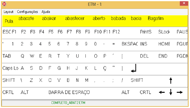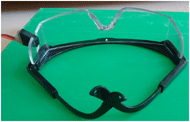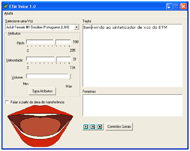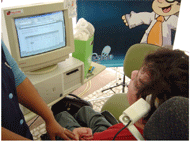CONFIGURABLE AND CUSTOMIZABLE MULTI-LAYOUT VIRTUAL KEYBOARD FOR DISABLED PEOPLE
Alexandre Felippeto Henzen, Aurélio Flávio Charão, Percy Nohama
Graduate Program in Electrical and Computer Engineering (CPGEI)
Federal University of Technology - Paraná (UTFPR), Brazil
ABSTRACT
Assistive technologies are helping people without speech or functional writing, whether total or partial, to speak or write through alternative methods and systems. The area that deals specifically with this theme is called alternative communication. One of the existing systems to solve this problem is the emulation of keyboard and mouse. The goal of this paper is to present ETM system: a configurable and customizable keyboard and mouse emulation software, freeware, which allows people with special needs to use all the features of the keyboard and mouse on a Windows running computer via sensors connected to the suitable part of the user's body. ETM has been adopted by people and institutions assisting people with disabilities. And it demonstrates efficiency as a solution for alternative communication for people without speech and motor difficulties.
INTRODUCTION
Communication requires the ability to transmit information through different codes and systems governed by general rules, so that the subject can interact with others and integrate into society. Through speech, associated with gestures, facial and body expressions, we interact with other people, communities and cultures, forming social bonds, thus characterizing the human condition [1].
The area of assistive technology which is specifically targeted to the expansion of communication skills is called Alternative and Augmentative Communication (AAC). AAC helps people without speech or writing ability to speak and/or write [2].
As a result of such communication limitations imposed to people with disabilities, both written and oral, methods and alternative communication systems are required [3].
Sensory, cognitive or motor difficulties can compromise all or part of human communication skills, which can be complemented with a support system and Alternative Augmentative Communication (AAC). These alternative mechanisms are less efficient than the natural ones, with significantly less typing speeds [4]; however, in many cases, they may be the unique alternative for those with reduced mobility to access the computer and communicate with the world.
To meet this demand, we developed a keyboard and mouse emulator software with low cost sensors, able to meet a large portion of the population with some kind of physical disability that impairs their communication.
Among the various compromising diseases of human communication, we can mention Cerebral Palsy, which causes disorders in motor development, without necessarily affecting the intellectual capacity of the individual, but greatly compromising their communicative capacity [5].
ETM is different from other solutions by the adaptability to meet the particularities of each person through its customization features that will be described in this article.
So, in this paper we present and discuss ETM development and application.
MATERIAL AND METHODS

The program acquires signals from sensors connected to the computer inputs, turning on the keyboard and mouse actions, allowing the user to use all features of the keyboard and mouse. These sensors are attached to the wheelchair or the user's body. For example, to use the software, the person with paralysis that only moves the head presses a key coupled to the back of the wheelchair. With the movement of the head, a signal is sent to the computer that executes the command indicated on the virtual keyboard or the virtual mouse displayed on the screen.
Figure 1 shows the application architecture. The software consists internally of a layouts manager, responsible for the visual part of the virtual keyboards, a script processor for processing chained commands, one device manager to acquire signals from the sensors and the command processor that is the central part responsible for emulation of keyboard and mouse. Emulation means to declare to the operating system to type characters as if received from the keyboard and to click or move the cursor as if received from the mouse. All combinations are allowed like Ctrl-C or Ctrl-V.
Input Devices

USB Joystick:
currently, it is the most widely used input device due to its simplicity, ease of acquisition and low-cost. One advantage of Joysticks is that they use the HID protocol (Human Interface Device) [7], which is a universal connection, not requiring any additional driver installation, which makes it compatible with most operating systems on the market. When connected to the USB port, ETM recognizes the command buttons, and one can set them individually for each type of action. If the automatic scanning system is disabled, the user can choose a command for each action. For example, one can configure the A Button to skip the lines, the B button to jump the columns, and the C button to choose the selected layout key. As a joystick is not suitable for a person with physical disability, we must open it and weld wires to the corresponding contacts. Once connected, these wires are attached to keys adapted for wheelchairs or body.
Serial Port:

Serial Port, or RS232C, is very suitable to be transformed on ON/OFF sensors, just connecting two wires to DTR pin (Data Terminal Ready) and CTS (Clear to Send). By software, the user can poll (test) the condition of CTS and state whether the contact is made or not. The same may be done for some other pins.
As simple as this, ETM took command of all keyboard and mouse actions, just at the touch of one switch, provided Automated Scan is on. One can dismiss Automated Scan in order to improve the speed, simply connecting three Serial Port pins and providing three buttons (sensors) to the user.
Microphone:
The microphone's role as sensor is to acquire any sound that indicates a command to be executed. When the software receives a noise signal picked up by the microphone, this signal is filtered and converted into a digital pulse, which is recognized by ETM indicating that an action should be executed.
Camera:
The camera feature was developed with the goal of acquiring the blink of the eye and turn it into an action. This sensor was not efficient due to calibration difficulties. This feature can be improved and was replaced by the optical sensor, which is more efficient.
Keyboard:
the computer keyboard may be used as a sensor. ETM disables all functions of the keys making them all work like a single button that can be pressed finding any limb of the body. For example, a keyboard can be set at a back of the wheelchair and be activated by the head. It is not recommended because this forbids the use of smart layouts, based on the so called “sendkeys” soft.
RESULTS E DISCUSSION
One of the advantages is the software allows the creation of layouts with customizable buttons. Unlike a computer user who uses conventional keyboards where the layout complies with industry standards such as the QWERTY arrangement, a user with special needs using virtual keyboard often want to change the key layout for better ergonomics, and even exclusion of some key strokes.
The software features a layout editor where you can create the layouts of keyboards, such as in Figure 2. For each layout it is assigned a name. It can be loaded when ETM is running, through a menu.
A layout is a set of buttons, not a set of keys as on a conventional keyboard, where each key has its function. Each layout button can receive some properties, besides its function. A sound can be associated to a button. An image can be associated to a button. Complex functions can be associated to a button.
Properties
(1) Image File: allows you to associate an image with a button. This property is useful when the user wants to create layouts with images representing the letter or text or action being sent / performed;
(2) Sound File: allows the user to associate sound files in Wave format. In this case, the sound will be played when a button is about to be chosen. This helps visual impaired users;
(3) Cursor File: allows you to associate the Windows cursor type files. In this case, the mouse cursor shape is changed to the shape of the cursor assigned to when the button is selected.
Text Key: its function is to simulate the character key. The main difference is that character keys are already preset for execution of the command in hand. For example, if one adds the letter A key on the layout, it is already configured to send the letter command. The text key allows, in a single action, send text or a series of commands, rather than sending a single character. This key has a property called Text, where the user can configure set phrases.
Shortcut for Layout: ETM allows user to add a button on the layout containing a name of another layout so that the user can switch between layouts. For example, if the user is using a layout with letters from A to Z and want to change to another containing only the mouse buttons. This allows small, efficient layouts. There will be a gain in the scan time, too.
Command Processor
ETM has a command processor system that allows sending a series of instructions for the operating system through the push of a single button. With this feature, the user can create a task automation processes facilitating his day-to-day. For example, he can create a button to load a program, perform tasks such as Ctrl + C (Shortcut to copy selected text), select text, save files in a text editor, among others. It is considered one of the main features of the software. It is implemented via the above mentioned Text Key. There is a SendKeys.txt file explaining its use. [6]
Keyboard Emulator
ETM works in the scanning mode; it can be automatic or manual. In the case of automatic scanning, highlighted with color lines will be skipping at a configurable time until the sensor is pressed.
Figure 3 illustrates ETM interface for the custom layout. The system works as follows: letters, numbers and arrows indicating mouse movement are scanned all the time, by label (line highlighted in yellow). When the marker is positioned on the desired line, the user triggers the sensor and the highlight is now on the characters of the selected line. To choose a character, the user presses the sensor to activate the letter or command he wants.
Mouse Emulator

Figure 4 shows an ETM layout with buttons with all mouse options, plus keyboard arrows.
Sensor Example

Being a small and low-power circuit, it is generally fixed internally on the joystick. So, it is not necessary external energy source for operation because their power is supplied by the USB port. Figure 5 shows a pair of glasses adapted to the optical sensor.
ETM Voice

ETM Voice allows its use with any text editor. The user needs simply to select the text and press Ctrl-C! In doing so, the program starts talking the text automatically in Portuguese. Figure 6 illustrates ETM Voice Interface. This interface may be transparent to the user because it can be hidden.
Configuration Interface
The graphical interface configuration must be done by someone able to use the true mouse. It is not possible to configure ETM or edit layouts, using ETM. This is to prevent the user (a disabled person) to unwillingly interfere with the setting parameters. Delays, sizes, sensors choices, background and foreground colors are among settings (configurations) offered to customize the software.
Application
ETM is being used by several people and schools as a communication tool. It has been adopted by many people and institutions assisting people with disabilities in Brazil.

CONCLUSION
In this paper, we presented ETM system: a powerful configurable and customizable keyboard and mouse emulation software for AAC. It has been demonstrating efficiency as a solution for alternative communication for people with speech and motor difficulties.
The software can be downloaded for free through the project website [8]. All requests made on the project website [8] are analyzed and defined together with those responsible for the user. The challenge is to define which sensor best fits the need. ETM is constantly evolving and new studies have been conducted to add features such as artificial intelligence in predicting words to make it more versatile and agile.REFERENCES
- Miranda, Leidy e Gomes, Ivone. Contribuições da comunicação alternativa de baixa tecnologia em paralisia cerebral sem comunicação oral.
- Sartoretto, Mara e Bersh, Rita. 2014. http://www.assistiva.com.br/ca.html. Assistiva Tecnologia e Educação. [Online] 2014. http://www.assistiva.com.br/ca.html.
- Jordan, Monica. 2007. Predição de Palavras baseada em Modelos Ocultos de Markov. s.l. : Universidade Tecnologica Federal do Parana, 2007.
- Garcia, Luis e Luis, Oliveira. Sistema de CAA com Adaptação ao Contexto
- Henzen, Alexandre. 2003. Acessibilidade ao Computador para Portadores de Paralisia Cerebral. Junho de 2003.
- Microsoft SDK. SendKeys. http://msdn.microsoft.com/pt-br/library/system.windows.forms.sendkeys(v=vs.110).aspx
- USB, Usb Specification. http://www.usb.org
- Projeto ETM. http://www.projetoetm.com.br